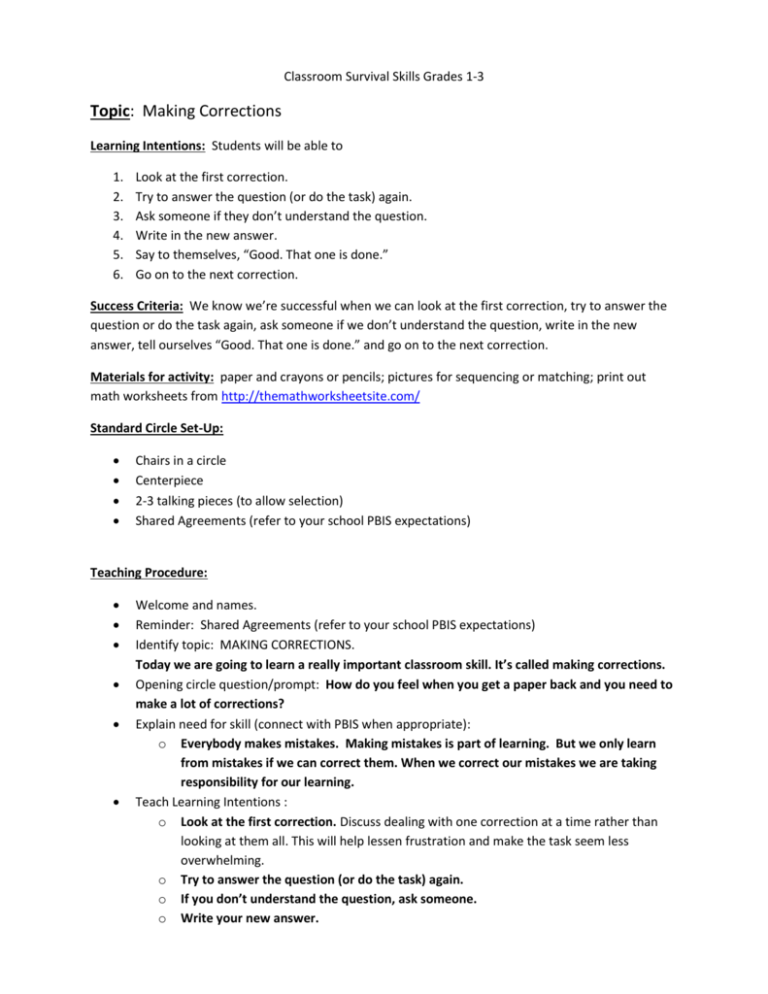Essential Skills For Providing Corrections And Clarifications

Table of Contents
Active Listening and Empathy
Understanding the recipient's perspective is paramount before offering corrections or clarifications. Effective communication starts with empathy and a genuine desire to help the other person understand. Ignoring this crucial first step often leads to defensiveness and resistance, hindering the entire process of providing helpful feedback.
Understanding the Recipient's Knowledge Base
Gauging the recipient's existing understanding is vital to tailoring your approach. Avoid making assumptions about their knowledge level.
- Ask clarifying questions: Instead of assuming understanding, ask open-ended questions like, "Can you explain your understanding of...?" or "What are your thoughts on...?" This helps you pinpoint exactly where the misunderstanding lies.
- Use appropriate language: Avoid jargon, technical terms, or overly complex sentences if the recipient may not be familiar with them. Simplify your language to ensure clarity and comprehension.
- Adapt your explanation to their learning style: Consider whether the person is a visual, auditory, or kinesthetic learner. Adjust your delivery method accordingly – using diagrams for visual learners, verbal explanations for auditory learners, or hands-on activities for kinesthetic learners.
Demonstrating Empathy and Respect
Approach the situation with sensitivity and respect, focusing on the task or issue, not the person. Your aim is to help them improve, not to make them feel inadequate.
- Use "I" statements: Frame your feedback around your observations, avoiding accusatory language. For example, instead of saying, "You made a mistake," try, "I noticed a discrepancy in the report on page three."
- Maintain a calm and respectful tone: Both your verbal and nonverbal communication should convey respect and understanding. A calm demeanor helps create a safe space for the recipient to receive and process the feedback.
- Acknowledge their efforts and contributions: Before delivering corrections, acknowledge the recipient's efforts and positive aspects of their work. This helps to soften the impact of the corrections and promotes a more receptive environment.
Clear and Concise Communication
Delivering your message in a clear, concise manner is key to effective feedback. Ambiguity only leads to further confusion and misunderstandings. Structure and precision are paramount in delivering corrections and clarifications.
Structuring Corrections and Clarifications
Use a logical and organized approach to ensure your message is easily understood.
- Begin by stating the specific issue: Clearly define what needs correction or clarification. Avoid vague statements and get straight to the point.
- Provide specific examples: Illustrate your points with concrete examples to make your feedback more tangible and easier to understand. Show, don't just tell.
- Offer concrete solutions or alternative approaches: Don't just point out the errors; provide clear and actionable steps for improvement.
Choosing the Right Medium
Consider the context and choose the most appropriate communication channel.
- Email: Suitable for formal corrections and detailed explanations that require a written record.
- Face-to-face conversations: Best for sensitive issues requiring immediate feedback, nonverbal cues, and the opportunity for immediate clarification and discussion.
- Phone calls: Appropriate for quick corrections and clarifications, particularly when immediate feedback is needed but a face-to-face meeting isn't feasible.
Constructive Feedback Techniques
Focusing on improvement rather than criticism is crucial for effective corrections. The goal is to help the recipient learn and grow, not to reprimand them.
Focusing on Solutions, Not Problems
Emphasize what needs to be done to improve, not just what went wrong.
- Provide actionable steps for improvement: Give the recipient clear, concise steps they can take to address the issue.
- Offer support and resources: Provide additional support or resources, such as training materials or mentorship, to aid in their improvement.
- Set clear expectations for future performance: Outline clear expectations for future tasks to prevent similar issues from arising.
Utilizing the Sandwich Method
The sandwich method—positive feedback, constructive criticism, and positive reinforcement—is a highly effective technique for delivering feedback constructively.
- Start with positive feedback: Begin by highlighting the recipient's strengths and positive contributions to build confidence and create a receptive environment.
- Offer constructive criticism with specific examples: Deliver your corrections clearly and specifically, using concrete examples to illustrate your points.
- End with encouragement and positive reinforcement: Conclude with positive reinforcement to boost confidence and leave the recipient feeling motivated to improve.
Handling Difficult Conversations and Pushback
Addressing resistance and disagreement effectively is critical. Not everyone will readily accept corrections or clarifications, so learning to navigate these situations gracefully is essential.
Remaining Calm and Professional
Maintain composure even in challenging situations. Your calm demeanor can help de-escalate tension and create a more productive conversation.
- Listen actively: Listen to understand their concerns and perspective, even if you don't agree with them. This demonstrates respect and helps build rapport.
- Emphasize mutual goals: Remind them of shared objectives and how addressing the issue contributes to achieving those goals.
- Seek compromise: Explore ways to find mutually acceptable solutions. Flexibility and a willingness to compromise can help resolve disagreements.
Documenting Corrections and Clarifications
Maintaining records can avoid future misunderstandings and disputes. This is especially important in professional settings.
- Keep a record of all communication: Maintain a detailed record of all communication related to corrections and clarifications.
- Use a consistent format: Use a consistent format for documenting feedback, ensuring clarity and ease of retrieval.
- Save copies of emails, notes from meetings, etc.: Keep digital and physical copies of all relevant documentation.
Conclusion
Mastering the skills of providing effective corrections and clarifications is essential for fostering clear communication and building positive relationships. By focusing on active listening, clear communication, constructive feedback, and managing difficult conversations, you can ensure your feedback is well-received and leads to improved understanding and performance. Remember to practice empathy, offer solutions, and document your interactions. Continue to refine your techniques to become a more effective communicator in providing corrections and clarifications in all your interactions. Improving your skills in delivering corrections and clarifications will significantly enhance your professional relationships and communication effectiveness.

Featured Posts
-
 Schneider Electrics Sustainability Leadership Winning The Worlds Most Sustainable Corporation Award
Apr 30, 2025
Schneider Electrics Sustainability Leadership Winning The Worlds Most Sustainable Corporation Award
Apr 30, 2025 -
 Eurovision 2024 Pride Flags Banned From Stage
Apr 30, 2025
Eurovision 2024 Pride Flags Banned From Stage
Apr 30, 2025 -
 Ru Pauls Drag Race Season 17 Episode 6 A Preview And Guide
Apr 30, 2025
Ru Pauls Drag Race Season 17 Episode 6 A Preview And Guide
Apr 30, 2025 -
 Guardians Rally Past Yankees After Bibees First Pitch Home Run
Apr 30, 2025
Guardians Rally Past Yankees After Bibees First Pitch Home Run
Apr 30, 2025 -
 Rare Photos Jay Z With Blue Ivy And Rumi Carter At The Super Bowl
Apr 30, 2025
Rare Photos Jay Z With Blue Ivy And Rumi Carter At The Super Bowl
Apr 30, 2025
